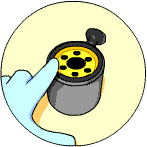How to Change an Oil Filter
Created | Updated Mar 21, 2005

It is a sad fact of life that nearly 70% of the people who pass driving tests do not know how to change their oil, and yet it is a task that should be done every 6 months (or every 6000 miles, whichever occurs first1). Consequently, many people drive around with old or dirty oil, leading to engine degradation. This is a simple guide to performing a Do-It-Yourself oil change.
What You Need
- New oil (make sure you have the correct grade for your engine)
- New oil filter (again, make sure it is the correct make)
- New oil cap and sump plug washer (optional, depending on car)
- Spanner or socket set to fit sump plug (see below)
- Chain wrench
- Latex Gloves (recommended, because engine oil can be an irritant)
- Jack (depending on car)
- Container for old oil2
- Axle stands
- Wheelie board (if you don't like getting your clothes dirty)
The Procedure
Do not perform an oil change within two hours of driving the car, otherwise you may scald yourself on the hot oil, and the dipstick will not show a true reading. It is, however, a good idea to run the engine at low revs for no more than two or three minutes beforehand to thin the oil, and aid the draining.
Make sure your car is on a hard, flat surface to ensure jacking stability.
Open the bonnet and remove the oil-filler cap. The cap is usually plastic, and located on top of the engine block. Check the air vents in the cap - if they are clogged, replace the whole cap.
Locate the sump plug and oil filter. The sump plug will have the appearance of a bolt-head, usually hexagonal, facing downwards (or occasionally sideways) and is usually just to the rear of the engine. If these are accessible without having to jack up the car, then skip stages 5 and 13.
Jack up the front end of your car. It is not advisable to leave the weight of your car resting on the jack for any length of time, so it is important to place axle stands under the front axles as a double-measure.
Using the spanner/socket set, start to unscrew the sump plug anticlockwise and ready the container to catch the oil. Ensuring that your head is not directly beneath the plug is a good move at this point, unless you want a face full of oil.
Take the last few turns of the sump plug off by hand, and let the oil drain into the container. Keep an eye on the container, as the flow of oil is likely to move as the sump empties. The used oil should be taken to a garage or refuse disposal site where it can be properly disposed of.
The tip of the sump plug is magnetic. Gently wipe the oil off and inspect it. If there are lots of small metal filings sticking to the tip, this means that your engine is degrading. This can be due to a number of reasons, including rust. To be on the safe side make sure you change the oil more frequently in future.
Some sump plugs have a washer to ensure a good seal. Make sure this does not fall off, and if it looks at all damaged, replace it.
Unscrew the oil filter anticlockwise. In theory this can be done with your hands, but most of the time you will have to use a chain wrench because:
The filter is slightly too large to get a grip on, unless you are Dr Bruce Banner3.
The rubber seal will have contracted.
Your hands will, quite probably, be covered in oil and grease and you won't be able to get a grip.
In any case, be prepared for a bit more oil to escape, so don't get your head in the way.
A last resort, if you're still unable to remove the filter with the chain wrench (and, given that now your car has no oil in, you can't drive it to a garage), is to hammer a screwdriver tip in through the filter wall, and use this as a basis for leverage to unscrew the filter. Be careful that you don't shear the thread, however.
Wipe a thin layer of oil around the rubber seal of the new oil filter to ensure a perfect contact.
Screw the new filter in to hand tightness only. Too tight and you will strip the seal or break the threads.
By this point, the oil should have finished draining, so replace your sump plug4, tightening roughly one half-turn past hand-tightness with the spanner/socket set.
Remove the axle stands and jack the car back down, otherwise you will get no reading on the dipstick.
Locate the dipstick. It is a removable thin metal strip, marked with the recommended upper and lower oil levels. Wipe the old oil off the dipstick and replace.
Pour in the new oil, about a pint at a time. After each charge of oil, give it 30 seconds to run down through the engine, and check the level on the dipstick. Continue filling until the oil level approaches the upper level on the dipstick.
Replace the oil-filler cap and close the bonnet.
Start the engine, and check that the oil warning light goes out. Run the engine for a few minutes, and check that there are no leaks in the system.

